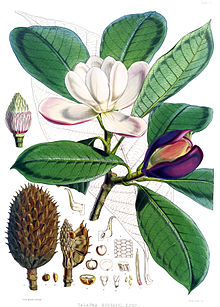Magnolia hodgsonii
| Gai lie mu | |
|---|---|

| |
Color plate from Illustrations of Himalayan plants, by Joseph Dalton Hooker, et al. For the original caption see notation[1] | |
| Scientific classification | |
| Kingdom: | |
| (unranked): | |
| (unranked): | |
| Order: | |
| Family: | |
| Genus: | |
| Subgenus: | |
| Section: | |
| Species: | M. hodgsonii
|
| Binomial name | |
| Magnolia hodgsonii | |
Magnolia hodgsonii (syn. Talauma hodgsonii), known in Chinese as Gai lie mu is a species of Magnolia native to the forests of the Himalaya and southeastern Asia, occurring in Bhutan, southwestern China (Xizang), northeastern India, northern Myanmar, Nepal, and Thailand. It grows at moderate altitudes of 850–1500 m with a subtropical climate.[2]
It is a small evergreen tree up to 15 m tall. The leaves are obovate-oblong, 20–50 cm long and 10–13 cm broad, with a leathery texture. The flowers are fragrant, with nine tepals up to 9 cm long, the inner tepals white, the outer ones greenish; they are produced in April to May. The fruit is 13–15 cm long, composed of an aggregate of 40-80 follicles.[2]
The wood is "very soft and worthless". Like almost all Himalayan Magnoliaceae, M. hodgsonii flourishes in a stiff clay soil.[3]
See also
References
- ^ Hooker, Joseph Dalton; J. F. Cathcart; W. H. Fitch (1855). Illustrations of Himalayan plants. London: L. Reeve. pp. 35–36. LCC QK349.33 .H66 1855.
"Flowering branch of Talauma hodgsonii with a full-grown leaf of a young tree behind, of the natural size. Fig. 1. Stamens and column of ovaria. 2. Stamen. 3. Transverse section of stamen. 4. Pollen. 5. Ovary. 6. Longitudinal section of ovary all magnified. 7. Ripe fruit. 8. The same with most of the carpels removed, showing the woody alveolate axis and insertion of seed. 9. Seeds all of the natural size. 10. Vertical, and 11, transverse sections of seeds. 12. Endopleura and albumen. 13. Portion of endopleura (very highly magnified). 14. Vertical section of albumen and embryo. 15, 16. Embryos all magnified." - ^ a b "Talauma hodgsonii". Flora of China . Retrieved June 12, 2009.
{{cite web}}: CS1 maint: extra punctuation (link) - ^ ibid. (p.35, Hooker, et al)
External links
- Flora of China: Magnoliaceae. Treats species as Talauma hodgsonii.
- Plant Novelties: Talauma hodgsonii from Mildred E. Mathias Botanical Garden newsletter
